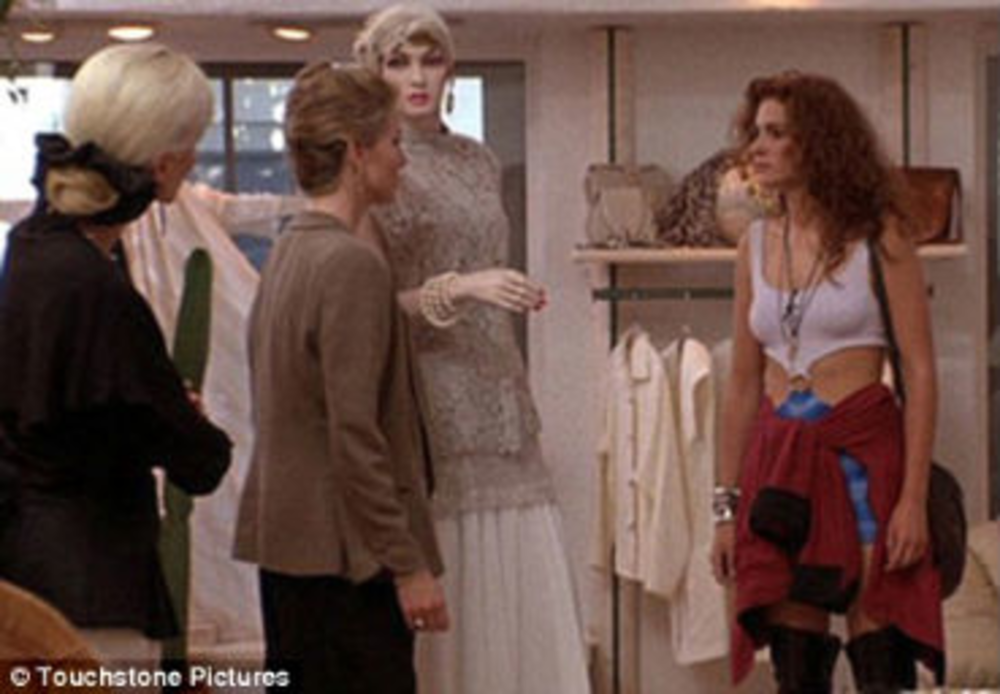Try this offline experiment this holiday season: Walk into Tiffany with a bag from JC Penney and see if anyone will talk to you. Next, go to JC Penney with a bag from Tiffany and watch the staff fawn all over you.
Online personalization is an evolving and very dynamic space. The algorithms behind personalization sift through reams of data and supply us with tailored recommendations, advertisements, and the most personally relevant and appealing results.
Because online personalization is on the cutting edge, we sometimes forget we’ve been targeted for decades while shopping in brick and mortar stores. Old-school targeting faces a similar set of problems because it’s about visually sizing up customers. Take Vivian, the character played by Julia Roberts in the movie “Pretty Woman,” who reenters the posh shop on Rodeo Drive where a day earlier, dressed in her “working girl” clothes, she was snubbed by the shop assistant. Now, wearing an expensive dress, black hat , and white gloves—the very image of elegance—she’s loaded with shopping bags. The shop assistant smiles and asks if she needs help.
Vivian: “I was in here yesterday, you wouldn’t wait on me.”
Shop assistant: “Oh. ”
Vivian: “You people work on commission, right? ”
Shop assistant: “Yeah. ”
Vivian: “Big mistake. Big. Huge. I have to go shopping now.”
The shopkeeper’s targeting mistake was fictional, but every day millions of dollars hang on sellers properly sizing up their prospects.
Never in my life have I been referred to the women’s department when entering a clothing store because employees quickly surmise that I’m probably not looking for a dress—but they might be wrong. I could like wearing dresses, or, maybe I’m buying a gift for my wife, mother, or daughter. But they play the odds and refer me to the men’s section. Additionally, because I’ll never be confused with a fashionista, they’re also likely to recommend a new pair of khakis rather than the luxury cashmere hoodie made from the soft wool of Mongolian goats.
Online personalization is similar. When you visit that same clothing retailer’s online site, the algorithms attempt to determine something about you and customize the content to fit. It’s all about probabilities—the better the data and the better the algorithm, the better the chance they’ll hit the mark and show you something you like.
Of course, just as I can cloak my identity online using a cookie blocker, I can also cloak my identity offline. If I don’t want a store clerk to know I ‘m a man, I could wear a large parka and mask (though they might call security to escort me out). If I cloak my identity online, I’ll get a less interesting experience or just be ignored.
Old-school targeting happens everywhere. I know a single woman who wears a wedding ring when she travels because she gets better service from the airline and the hotel. Sadly, society still discriminates based on appearance. In old-school targeting we sometimes receive wonderfully customized service, but are also vulnerable to unpleasant experiences due to our looks, what we wear, our gender, or the color of our skin.
Humans naturally react to others based on many factors—some legitimate and some not. Store clerks need a filter to triage purchase intent because they can’t spend equal time with everyone who walks into the store. They need to allocate time to people they believe are going to buy, so they develop heuristics, based on their own biases, to help them interact with customers. If you walk into Tiffany with a JC Penney bag, you might be a billionaire, but my guess is that the store clerk isn’t going to take the time to find out—unless it’s a really great sales clerk who notices your brand of shoes or the wristwatch you’re wearing.
Old-school personalization is supposition based on our five senses. When practiced well, it can be very accurate. Online personalization lacks many of the cues one gets in the offline world, and, like store clerks, there are good and bad online systems. Good systems unify online and offline data and work on enhancing the experience of the customer.
Computers, like humans, have the same potential to do great good or cause harm. But unlike humans, computers can quickly digest millions of different interactions to make decisions. For instance, BestBuy.com can query its database to check if you’re an existing customer and what you purchased during your last visit. It would be impossible for a store clerk to remember the faces and purchases of millions of customers.
Stores, both brick-and-mortar and online, want our money and try to seduce us for it—except now, in the age of Big Data, it’s easier for the ones online to be masters of seduction. One hundred years ago, John Henry beat the machine at a severely high cost. Today, he wouldn’t even stand a chance.
Vivian tells Edward, “The stores are not nice to people — I don’t like it.” This is after she was snubbed. Edward responds, “Stores are never nice to people. They’re nice to credit cards.”
Auren Hoffman is CEO of CRM retargeting and data onboarding company LiveRamp.








